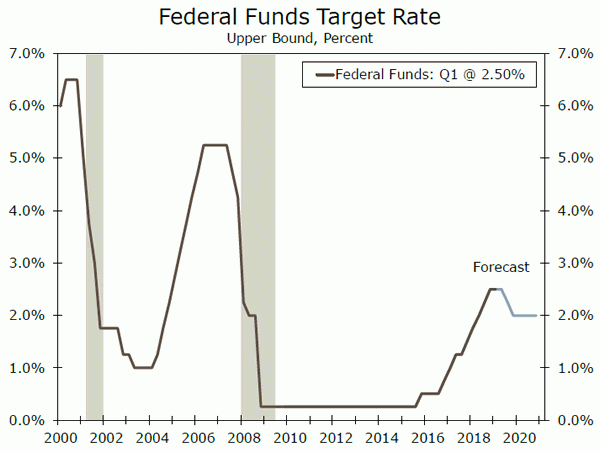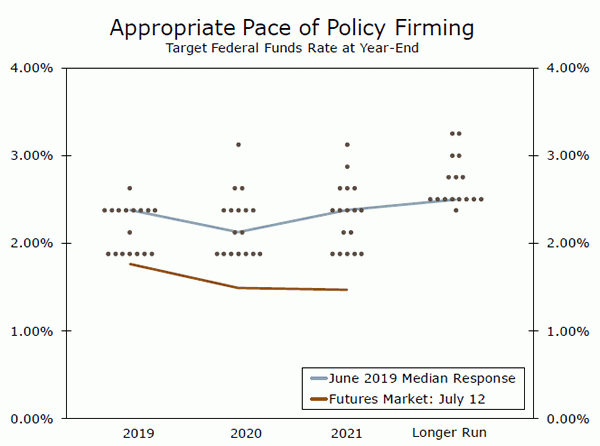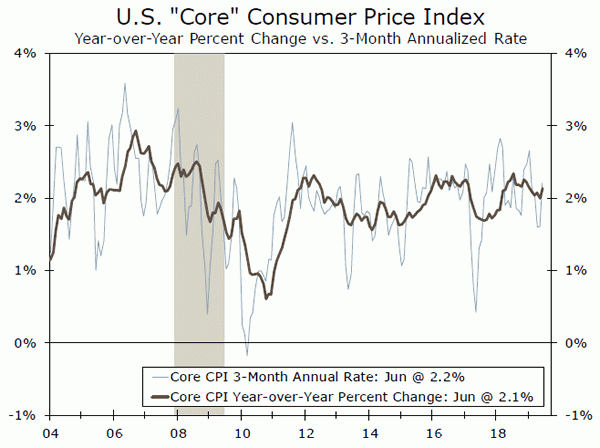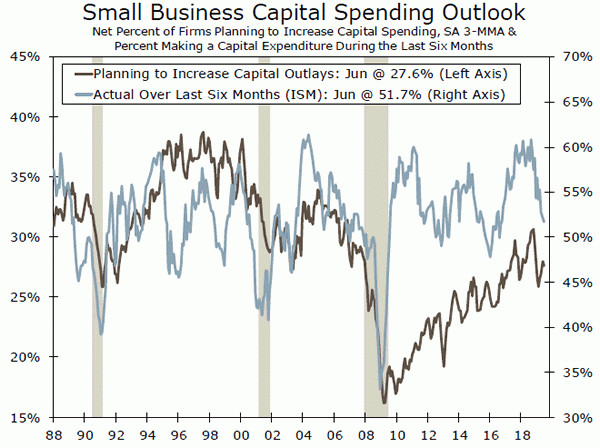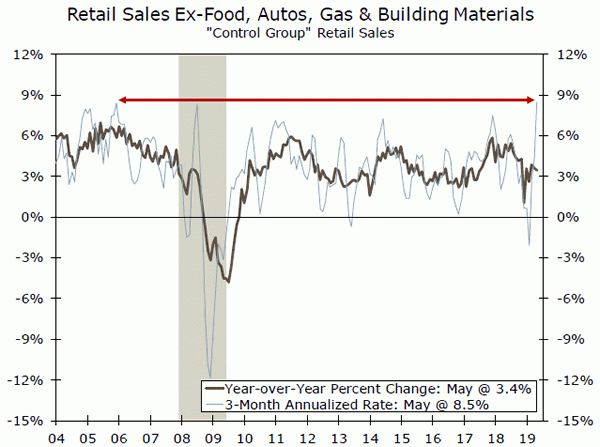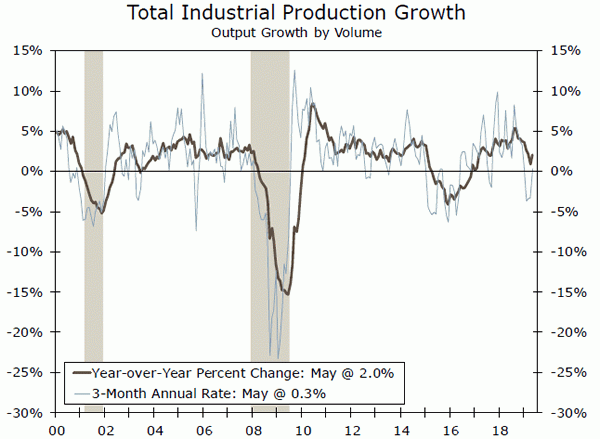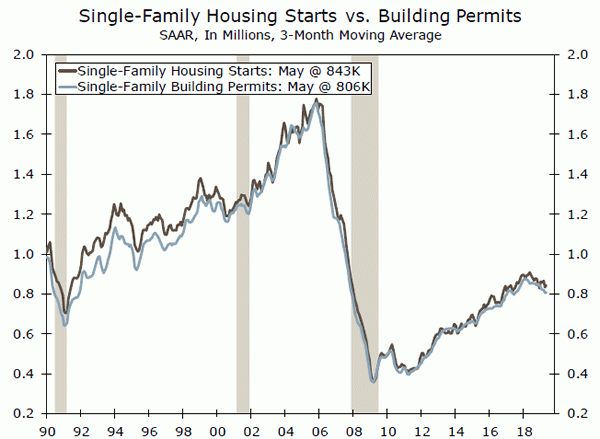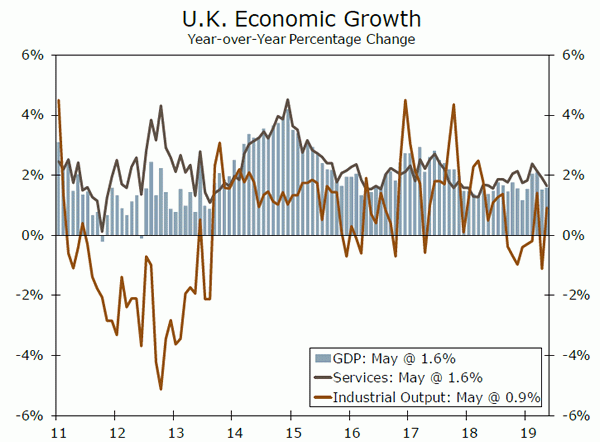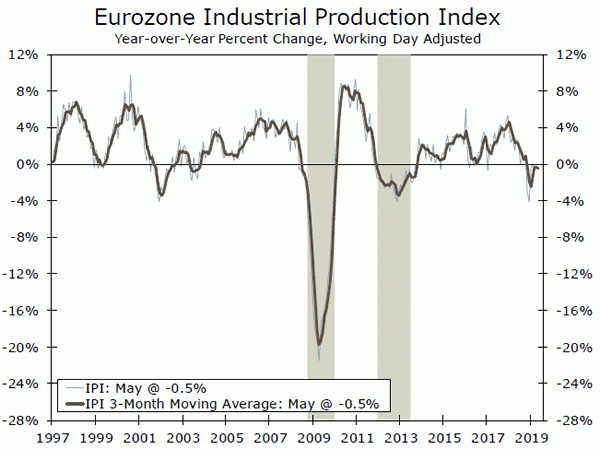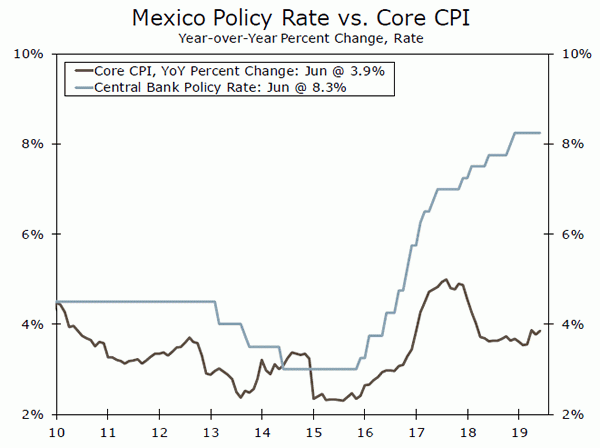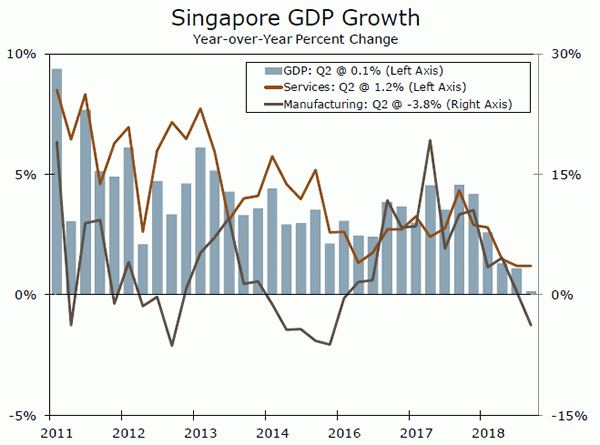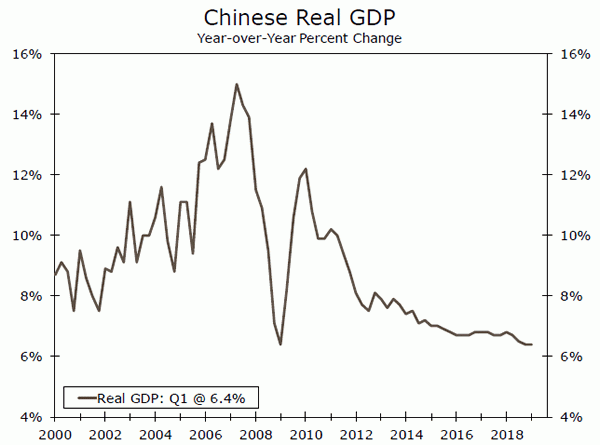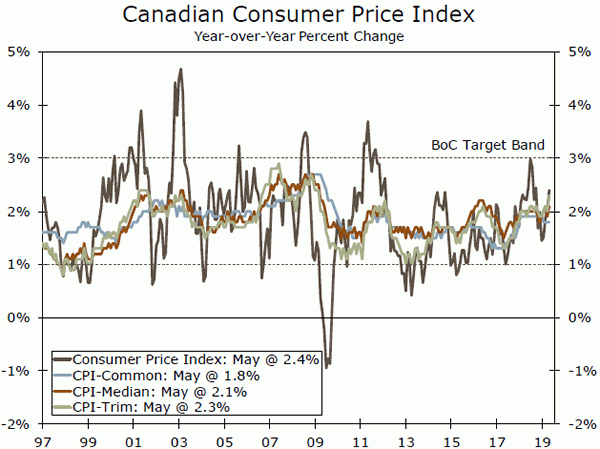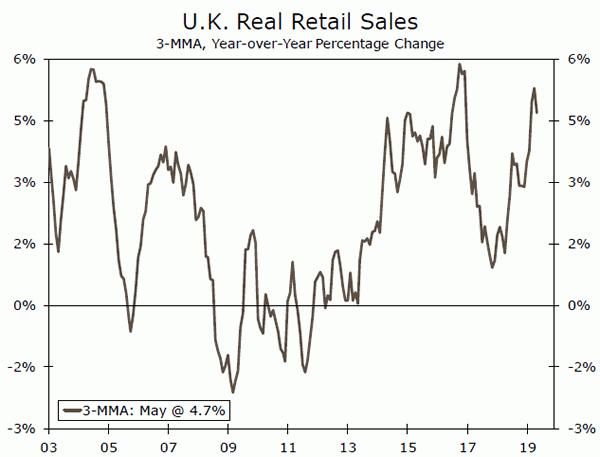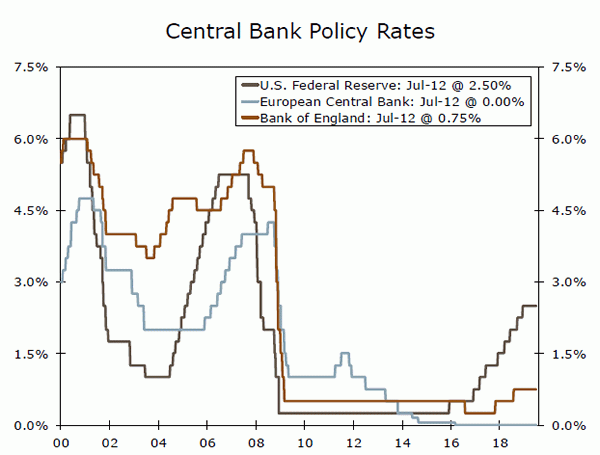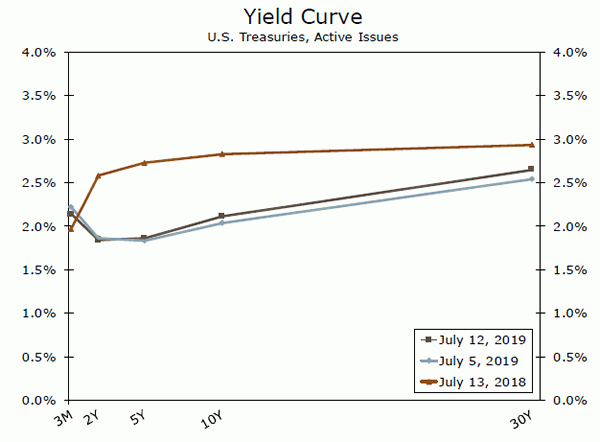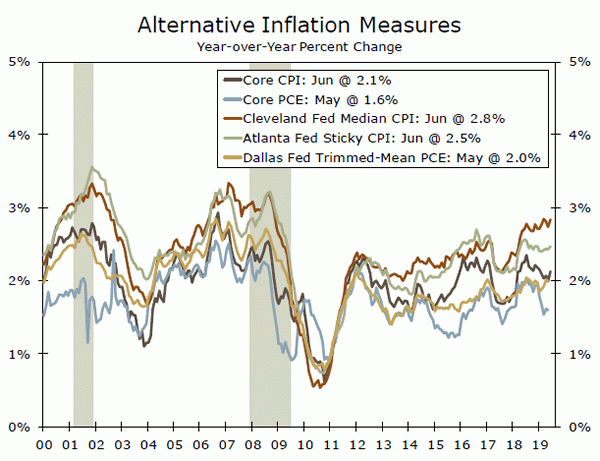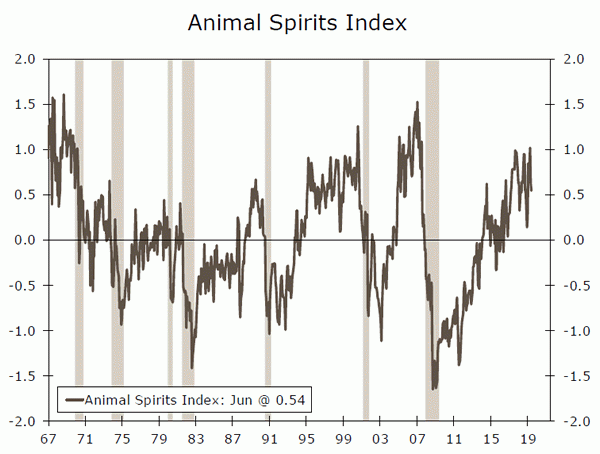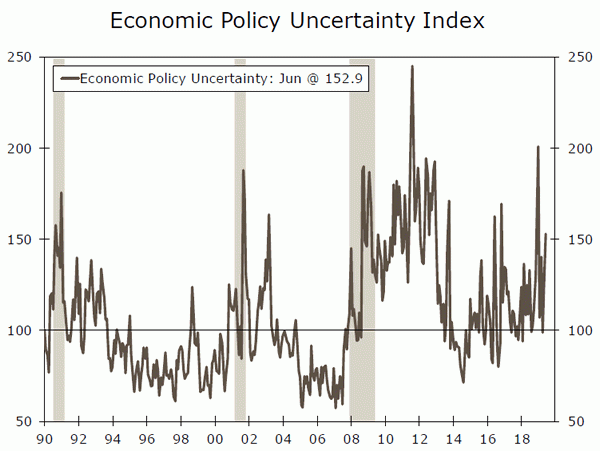U.S. Review
Fed Rate Cut Approaching in July
- Fed Chair Powell did nothing during his Semiannual Monetary Policy testimony to Congress this week to push back against the market’s view that the Fed will cut rates at its July 30-31 meeting.
- We expect that ongoing “crosscurrents” facing the U.S. economy will compel the Fed to cut rates both in July and again later this year, likely in October.
- The core CPI rose 0.3% in June, the largest monthly increase since January 2018, yet the generalized weakness in inflation this expansion further supports the Fed’s rate cut case.
“To Call Something Hot, You Need to See Some Heat”
Fed Chair Powell confirmed the market’s view that the Fed will cut rates at its July 30-31 meeting during his Semiannual Monetary Policy testimony to Congress this week. Some had speculated that Powell would push back against market expectations, if not regarding the expected timing of cuts then at least the magnitude. Yet with markets expecting a total of more than 100 bps of cuts, Powell opted to instead merely reiterate the messaging from the June FOMC meeting—that the uncertainties surrounding the trade environment and deteriorating global fundamentals are sufficient to compel an insurance cut. The minutes from that meeting were also released this week, and pointed to the strong consensus behind a rate cut in July. As we expected, the strong 224K June jobs number did not significantly affect the Fed’s view; Powell did not mention it or the latest trade truce. We expect that ongoing “crosscurrents” facing the U.S. economy will compel the Fed to cut rates both in July and again later this year, likely in October. Perhaps more interestingly, Powell spoke surprisingly candidly about the Fed’s success meeting the full employment portion of its dual mandate, and added to the growing chorus of questions regarding the viability of traditional macroeconomic models of the relationship between unemployment and inflation. Powell stated that “we don’t have any evidence for calling this a hot labor market”, and argued that the economy has further room to run, particularly by drawing people back into the labor force and boosting wages for those who were late to join the expansion, which is now the longest on record. Powell reiterated that “inflation pressures remain muted” and wryly stated that “To call something hot, you need to see some heat”.
We did in fact get a few blips of heat this week— the core CPI rose 0.3%, the largest monthly increase since January 2018. Yet this follows four consecutive 0.1% readings. Meanwhile, the NFIB survey of small businesses reported that the proportion of firms raising prices jumped an eye-catching seven points. The selling prices measure is often viewed as a leading indicator for broad CPI inflation, perhaps suggesting some upside potential in coming months. Yet this number comes off of a low base, as the prior month’s reading was the lowest since December 2017. The core Producer Price Index also rose an above-consensus 0.3%, but the trend is still moderate. The inflation story remains the same— gradually rising towards the Fed’s 2% target, but unlikely to break meaningfully higher. What is more recent is the Fed’s impatience with this painfully slow convergence to its target. Worried about the downward drift in inflation expectations, policymakers see a cut as the best way to bring inflation decisively up, notwithstanding the added justification to ease stemming from trade uncertainty.
Thus while the S&P 500 opened at an all-time high this morning and the unemployment rate sits at 3.7%, the Fed has all but locked in a July rate cut. While this may contradict conventional wisdom, the current Fed Chair testified to Congress this week that the Phillips Curve, or the relationship between unemployment and inflation that has underlain monetary policymaking for decades, is now just a “faint heartbeat”. These are unconventional times.
U.S. Outlook
Retail Sales • Tuesday
On Tuesday we receive retail sales estimates for June, which will provide us with a complete look at how sales fared over the second quarter. We have recently nudged our Q2 personal consumption expenditures (PCE) forecast higher to 3.4% from 2.9% previously, as spending is already on solid footing for the period. Indeed, following two solid monthly gains, retail sales rose 0.5% in May. This pushed control group sales—which exclude volatile components and are a good proxy for consumer spending—up 8.5% on a three-month annualized rate. This is the fastest pace since 2006 and suggests PCE growth is tracking well north of 3% in the second quarter. Higher frequency data, such as the Redbook Index for same store sales— which covers a sample of U.S. retailers—suggest sales remained solid in June. But given a more recent wilting of confidence, we expect retail sales rose a more modest 0.2% last month.
Previous: 0.5% Wells Fargo: 0.2% Consensus: 0.2% (Month-over-Month)
Industrial Production • Tuesday
Later on Tuesday we will get a look at the production side of the economy. Reflecting slower global growth and ongoing trade uncertainty, manufacturing production has floundered this year and weighed on total industrial production (IP). The latest IP print for May, however, did show a rebound of 0.4%, with manufacturing production posting its first monthly increase this year. The ISM manufacturing index eased slightly in June, but suggested a continued expansion in manufacturing activity. Weakness in the new orders component of the index suggests production growth should remain modest. Uncertainty about the structure of future trading relations continues to linger, even despite Presidents Trump and Xi agreeing to further trade negotiations, which also suggests manufacturing will remain under pressure in coming months. We forecast that total industrial production rose 0.1% in June as challenges remain for the factory sector.
Previous: 0.4% Wells Fargo: 0.1% Consensus: 0.1% (Month-over-Month)
Housing Starts • Wednesday
On Wednesday, attention will turn to the housing market. New residential construction has struggled to gain momentum despite lower building costs and improved buying conditions. On a year-todate basis through May, housing starts are 5.3% below their prioryear pace. That said, the 1.269 million-unit pace hit in May is slightly above the pace averaged over the past six months. The increase in May permits was encouraging: single-family permits rose 3.7%, ending a five-month streak of declines. The gain in permits alongside more favorable buying conditions point to gradually improving activity over the summer. But, despite lower mortgage rates, a surge in activity remains unlikely. The NAHB Housing Market Index fell last month after hitting a seven-month high in May. Builders were likely discouraged by the prospects of an escalating trade war. We expect starts to notch a 1.246 million-unit pace in June.
Previous: 1,269K Wells Fargo: 1,246K Consensus: 1,260K
Global Review
Temporary Reprieve on the Global Front
- There were some mildly encouraging elements in this week’s international economic figures, although we believe this represents a temporary reprieve rather than the start of a sustained improvement.
- U.K. GDP rose 0.3% month-over-month in May, reversing most of its April decline. However the gain was led by the manufacturing sector, with activity in the important services sector flat on the month.
- Eurozone industrial production rose in May, but soft orders data and PMI surveys suggest further declines can be expected.
European Economies Still Sluggish Overall
The news this week from some of Europe’s key economies portrayed a picture of growth that is still sluggish overall across the region. May industrial activity data were released across the Eurozone, and showed a slight improvement from April. Eurozone May output rose 0.9% month-over-month, while by country German output rose 0.3%, French output jumped 2.1%, and Italian output rose 0.9%. That said, the May increase does not represent a decisive turnaround for the European industrial sector. Eurozone industrial output was still down 0.5% year-over-year and the Eurozone manufacturing PMI remains entrenched in contraction territory, while Germany’s factory orders suggest further declines for European manufacturing can still be expected.
There was a brief reprieve on the U.K. economic front as GDP rose 0.3% month-over-month in May, although that comes after a large April decline. Moreover, the increase was largely led by a jump in manufacturing output, with service sector activity flat on the month. With services accounting for the bulk of the economy and growth in that sector subdued, the consensus currently forecasts a small 0.1% quarter-over-quarter fall in Q2.
Latin American Central Banks Looking to Ease?
This week’s figures from Latin America have arguably moved two of the region’s central banks closer to cutting interest rates. The case is likely strongest for Mexico, where the policy interest rate is still high at 8.25%. The latest batch of data shows Mexico’s June CPI slowing to 3.9% year-over-over, while May industrial output declined 2.1% month-over-month and 3.3% year-over-over. Following a more dovish tone at the Bank of Mexico’s late-June monetary policy announcement, we think there is a decent chance the central bank will lower rates at its next monetary policy meeting in mid-August.
The case for lower interest rates in Brazil is not quite as compelling, with the central bank’s policy rate—the Selic rate—already at a record low of 6.50%. That said, this past week saw June CPI inflation slow noticeably to 3.4% year-over-year, while activity growth remains relatively subdued as evidenced by a slowing in May retail sales to 1% year-over-year. While Brazilian central bank easing is not part of our base case forecast, we think a rate cut cannot be ruled out.
News From the Trade War Frontlines
China’s June trade balance improved to a surplus of US$50.98B, although the underlying details were less encouraging. Exports fell 1.3% year-over-year, compared to the small gain seen in May, while imports fell a larger 7.3%. The external sector has of course been a key area of concern for China given its trade dispute with the United States, although the “truce” achieved on the sidelines of the June G20 meeting may help improve sentiment in the months ahead. Singapore’s economy has arguably been a casualty of the “trade war”, with Q2 GDP unexpectedly slumping 3.5% quarter-on-quarter annualized and slowing to 0.1% year-over-year, with most of the softness concentrated in the manufacturing sector.
Global Outlook
China GDP • Monday
Next week sees the release of some Chinese economic figures for the second quarter, which will give the latest reading on the health of the economy following the solid start in Q1. Most notable will be Q2 GDP data, which the consensus expects to rise 1.5% quarter-over-quarter, but slow to 6.2% year-over-year. We forecast growth will slow a bit more quickly, to 6.1%, while within that overall growth figure we expect that activity in the service sector held up better than in the manufacturing sector. Mixed confidence surveys and activity data during Q2, and uncertainty stemming from trade tensions with the United States, likely contributed to slower growth Q2.
Activity data for June are also on the schedule. Growth in retail sales is expected to ease to 8.5% year-over-year, while growth in industrial output should rebound modestly to 5.2% after a soft May reading. Overall economic trends remain subdued however, and a further growth slowdown seems likely.
Previous: 6.4% Consensus: 6.2% (Year-over-Year)
Canada CPI • Wednesday
Canadian consumer prices jumped more than expected in May, led by increases in several transportation-related costs, and the main focus next week will be to what extent that jump is reversed with the release of the June CPI. Lower gasoline prices will probably partly weigh on the CPI and overall we expect most if not all of the May jump to be reversed. With our forecast for the headline CPI to slow to 1.9% year-over-year. We expect the central bank’s core CPI inflation measure’s to print close to (or above) the 2% inflation target midpoint. Given a quickening in wage inflation, we would not be surprised to see Canadian inflation trends remain modestly elevated in the near-term.
The Bank of Canada held its policy rate steady this week, and while we don’t expect CPI trends will prompt the central bank to tighten, the Bank of Canada appears unlikely to join other G10 central banks in easing monetary policy,
Previous: 2.4% Wells Fargo: 1.9% Consensus: 1.9% (Year-over-Year)
U.K. Retail Sales • Thursday
After a (surprisingly) resilient start for the U.K. economy in 2019, the focus during the second quarter has shifted to the extent to which growth has subsequently slowed. A reversal of ahead of the initial end-March Brexit deadline has likely contributed to the downshift in growth, although consumer spending also appears to have weakened perceptibly during the second quarter. Retail sales fell on a sequential basis in April and May, after three straight monthly increases during Q1. Recent confidence surveys suggest the underlying trend in the retail sector remains soft, and the consensus expects another decline, of 0.3% month-over-month in June.
The June CPI is also on next week’s schedule, but should have little market impact. The headline CPI should rise 2.0% year-over-year and the core CPI 1.8%, both close to the inflation target.
Previous: -0.5% Consensus: -0.3% (Month-over-Month)
Point of View
Interest Rate Watch
Policy is on the Right Track
Powell’s congressional testimony this week came in very close to expectations. The Fed Chair highlighted the Fed’s primary areas of concern, most of which centered on deteriorating economic conditions overseas and the continued uncertainty surrounding trade negotiations and Brexit. Powell added in his concerns about how Congress and the President will come to terms with the debt ceiling for good measure, and also stated that they were not dissuaded at all by June’s strong employment report. We see little in the way of economic news that is likely to get in the way of a quarter percentage point cut in the federal funds rate at the July 31 FOMC meeting.
While a quarter point rate cut now appears certain, the stronger economic news and slightly higher-than-expected core inflation data have likely killed the idea of a half percentage point cut at the July meeting. Such talk always seemed simplistic to us. At face value, a half percentage point cut in the federal funds rate would steepen the yield curve because the funds rate would fall back below the 10-Year Treasury note. But a half point move might also spook markets and cause Treasury yields to decline, leaving the yield curve flat or even inverted. The Fed would then have fewer viable options.
The stock market appears to like the idea of a more dovish Fed. The major stock indices have also risen solidly since Powell’s testimony, as the recent inversion of the yield curve looks less menacing. Powell and Congress also earned some style points this week. Powell made his major points about the need to cut interest rates succinctly and convincingly and made a strong case that the risks from slower global growth and major unresolved issues like Brexit, trade talks and the impending U.S. debt ceiling more than outweigh concerns about easing at a time that the economy appears to be at or beyond full employment.
Powell also expressed little concern on inflation, despite the bounce-back in some core inflation measures. The bottom line on inflation is that it is lower than it should be for this point of the business cycle, which gives the Fed the leeway to cut 25 bps in both July and again later this year.
Credit Market Insights
Developments in Consumer Credit
U.S. consumer debt increased in May to $17.1B, expanding at a solid pace for the second straight month. Revolving credit including credit card borrowing reached a new high, climbing $7.2B from the previous month, the largest increase since October. However, the non-revolving sector, which includes educational and automobile loans, increased only $9.9B, the smallest increase since June 2018, after rising $10.5B in April,
The data suggest that consumer borrowing has remained strong, mainly due to higher wages and job growth. Household debt ticked up in the first quarter of 2019, increasing for the 19th consecutive quarter. Mortgage balances and auto loans also increased in Q1-2019, expanding 1.3% and 0.5%, respectively, while total credit card balances fell 2.5%. Meanwhile, the total amount of outstanding student loans increased to $1.49T in the first quarter, up $29B from the previous quarter. The growth in student loan debt continues to be a concern among some analysts as one of the country’s 2most widespread financial burdens.
Personal income and spending was also firmer in May, and PCE growth is now on track to come in above 3% in Q2. Consumer fundamentals remain strong, supported by stronger job growth, which helps to increase spending. Despite the strong consumer data, it will likely not be enough to dissuade the Fed from cutting interest rates at its July meeting.
Topic of the Week
Recent Volatility in the ASI
Previously, we have introduced an index to quantify Keynes’ “animal spirits”. Our Animal Spirits Index (ASI) is constructed using five variables to capture sentiment of major economic agents, in major sectors of the economy, to shed light on economic agents’ expectations about the near-term economic outlook. We utilize a dynamic factor modeling approach in constructing our index.
An ASI value above zero (positive animal spirits), suggests optimism, while a value below zero (negative animal spirits) indicates pessimism. The lowest value of the ASI was during the Great Recession in October 2008 when the index fell to -1.65 (top chart). The index proceeded to stay in negative territory until January 2014, consistent with the slow recovery from the Great Recession. The index has since remained in positive territory for the majority of the time since February 2014, as the economic expansion has gained steam and optimism has returned.
This week we updated our model, finding that the ASI has been volatile in the first half of 2019. Starting the year at 0.25, the index climbed to its highest level in the post- Great Recession era, 1.02, in April before falling back to 0.54 in June. The volatility in the ASI was a result of fluctuations in the equity market and policy tension. The policy uncertainty index fell to 98.7 in April after jumping to 201 in January (bottom chart). Meanwhile, the VIX has remained relatively calm in 2019. The two components of the ASI that are still under stress are the yield spread and the consumer confidence index. The yield spread has remained negative while the consumer confidence index dropped in June to 121.5 from 131.3 the previous month.
Although the yield curve has inverted in recent months, the ASI shows that economic agents are comfortable with the recent developments in the economic and financial worlds. It seems the economic policy environment along with the equity market recovery have driven the ASI higher for now. We will continue to update our ASI and report any significant changes in the index.




